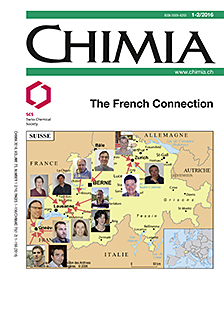Smart Contrast Agents for Magnetic Resonance Imaging
DOI:
https://doi.org/10.2533/chimia.2016.102Keywords:
Lanthanide complexes, Magnetic resonance imaging, Molecular imaging, Paramagnetic complexes, Responsive probesAbstract
By visualizing bioactive molecules or biological parameters in vivo, molecular imaging is searching for information at the molecular level in living organisms. In addition to contributing to earlier and more personalized diagnosis in medicine, it also helps understand and rationalize the molecular factors underlying physiological and pathological processes. In magnetic resonance imaging (MRI), complexes of paramagnetic metal ions, mostly lanthanides, are commonly used to enhance the intrinsic image contrast. They rely either on the relaxation effect of these metal chelates (T1 agents), or on the phenomenon of paramagnetic chemical exchange saturation transfer (PARACEST agents). In both cases, responsive molecular magnetic resonance imaging probes can be designed to report on various biomarkers of biological interest. In this context, we review recent work in the literature and from our group on responsive T1 and PARACEST MRI agents for the detection of biogenic metal ions (such as calcium or zinc), enzymatic activities, or neurotransmitter release. These examples illustrate the general strategies that can be applied to create molecular imaging agents with an MRI detectable response to biologically relevant parameters.Downloads
Published
2016-02-24
Issue
Section
Scientific Articles
License
Copyright (c) 2016 Swiss Chemical Society

This work is licensed under a Creative Commons Attribution-NonCommercial 4.0 International License.
How to Cite
[1]
C. S. Bonnet, Éva Tóth, Chimia 2016, 70, 102, DOI: 10.2533/chimia.2016.102.







